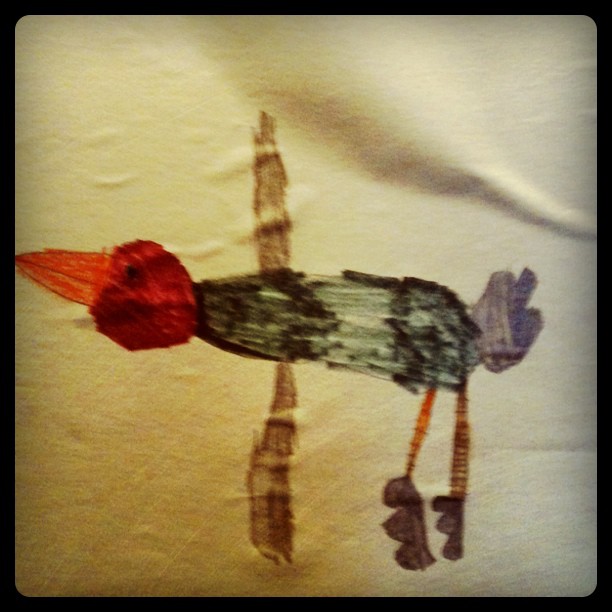In light of Monday’s post — which still fills me with warm fuzzies — I thought I’d share with you two of the drawing games we Boyetts have spent a lot of time playing. It’s great for kids to just sit and draw on their own, of course. But we enjoyed making a family game out of it. These two games are perfect for small groups and are therefore great for families to do together, especially parents and kids.
1. Same Subject, Many Artists (No, we don’t actually call it this. It doesn’t really have a name, and especially not a lame one like that.)
Each person needs their own drawing pad, paper, or notebook, along with a plentiful supply of crayons or markers.
One person is designated the suggester for each round. This person announces a scene, object, or subject to draw. (“Draw a flower” or “draw a volcano” or “draw a robot.”) Don’t give any more detail than that. Leave it wide open. Then everyone — including the suggester — produces a drawing, keeping it hidden from the rest of the participants. When everyone is finished, within a reasonable time, show your drawings to each other.
Then appoint the next person to be the suggester, and continue until everyone’s had a turn coming up with a topic.
Benefits:
• Everyone is going to approach the topic differently, using their own kind of creativity. You’ll rarely have any finished products that look alike.
• In showing their drawings, each person gets a chance to talk about why they drew it that way, or point out any particular details. Always fun to hear what goes on in the kids’ brains.
• The kids can learn from the adults when it comes to technique and creativity. They expected my drawings (along with my wife’s) to be more detailed than theirs, or more technically proficient, and rather than discourage them it tends to raise the bar higher. They saw me use a cross-hatching technique to shade the volcano so they might try that next time.
Drawbacks:
• Depending on your kid (and your own artistic talent), you have to be careful that they don’t get discouraged when they can’t draw as good of a robot as Mommy can. It’s a fine line between inspiration and frustration. For this reason, we usually just went one full round, with each family member getting a turn to be the suggester.
——————–
2. Draw What I Say (Yes, we do call it this.)
This one’s easy in description but plenty challenging execution. Like the above game, everyone needs paper and crayons or markers (we’ve also used whiteboards and erasable markers). One person is the caller. He or she comes up with a simple object to draw, like a tennis racket or a swingset or a house. But he doesn’t tell the other participants what it is. Instead, he draws that object himself WHILE instructing everyone else, audibly, how to do it. He doesn’t show them what he’s drawing. He doesn’t tell them WHAT they’re drawing. They only hear his description of the steps.
For instance, let’s say he decides to draw a house. Here’s how he might describe it to the participants.
• Start in the middle of the page. Draw an upside-down V. (This is the roof.)
• Draw two straight lines going down from the ends of the V. (These are the walls.)
• Draw a line at the bottom connecting the vertical lines. (This is the bottom of the house.)
• Draw a rectangle on top of the horizontal line, under the V. (This is the door to the house.)
• Draw a tiny circle inside the rectangle. (This is a doorknob.)
…etc.
Once everyone has completed all the steps together, you all display what you’ve drawn. Then you laugh, because usually the participants have no idea what they’ve been drawing until they see the caller’s picture. Depending on how good the caller is with the instructions — or how simple/complicated the subject — you will have some really weird final products that look nothing like the house (or whatever) you’re supposed to be drawing. It’s a lot of fun.
Benefits:
• It’s hilarious.
• You don’t have to be a good artist. In fact, your finished drawings rarely look like they’re supposed to even if you’re a great artist.
• Kids are often better at it than adults (who tend to “cheat” by guessing wrongly what the subject is and end up way off-course).
• Kids have to think ahead about what they’re going to draw and then guide participants step-by-step through the process. This requires some challenging (but very do-able) brain activity. Seriously, we’ve done it since our kids and their cousins were 4 or 5 years old, and they really can guide you through the drawing process.
Drawbacks:
• Adults may try to show off by describing a really complicated picture. It rarely works. But the results are enjoyably messed up and that still makes it fun.
——————–
Are we the only family that makes up drawing games like this? I hope not. If you’ve got your own, please share them.


